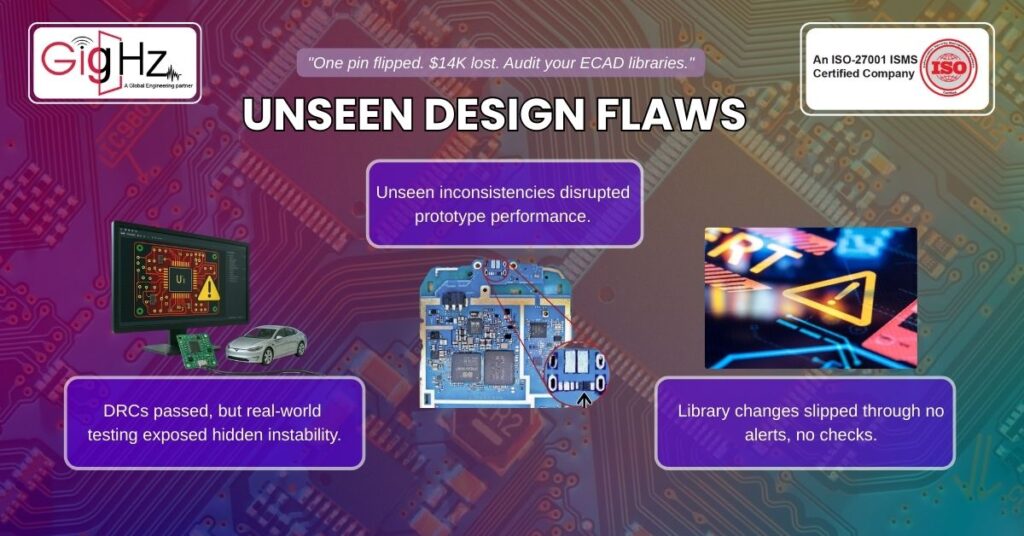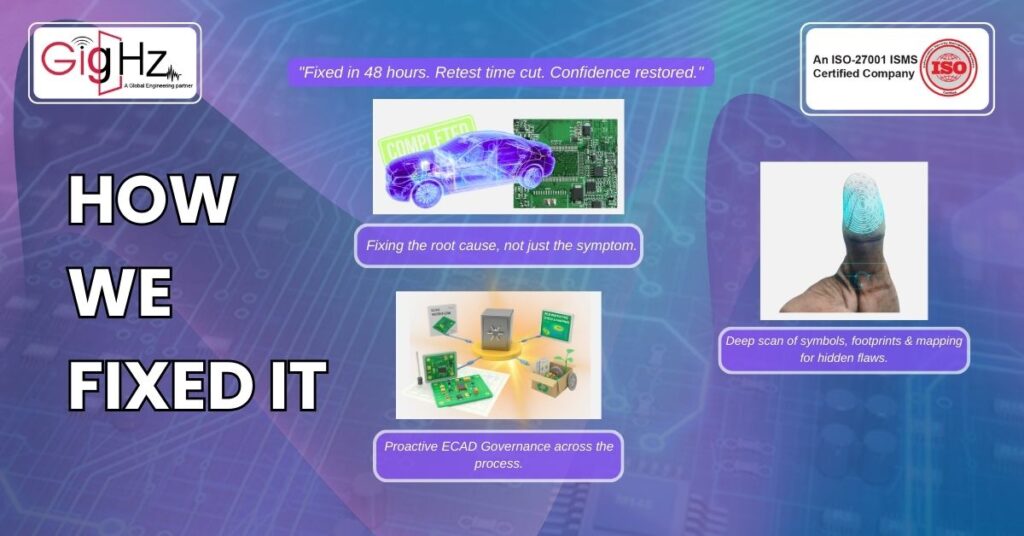Yes, it was just one symbol! Just a simple resistor.
However, it resulted in costing the team nearly three weeks of dedicated testing effort, delaying critical milestones.
Apparently, this is what happens when ECAD symbol and footprint accuracy is assumed and not verified instead.
1. Start with ECAD Libraries and Part Validation

So, an electric vehicle OEM company approached us with a very odd issue!
It was a board that worked perfectly in the simulation while passing the initial DRCs but it was acting unstable during in-vehicle testing.
Initially, the engineering team suspected thermal drift or sensor calibration issues which are common in vehicle systems.
However, after some prolonged hours into debugging, running thermal analyses, and swapping out sensors – the answer emerged:
A single mirrored pin assignment buried deep in a symbol.
- A mirrored pin assignment in a symbol.
- Then, a mismatch between schematic and layout.
- And a small issue that triggered a $14,000 delay in prototype validation.
Consequently, it boiled down to an entire library error that had not been caught because they skipped a full ECAD library audit.
Besides, this wasn’t a rookie team at all. On the other hand, they were a seasoned engineering department with solid processes.
However, their PCB library version control system had not flagged the silent shift at all!
Apparently, the change management in ECAD was more of a spreadsheet than a structured process.
How We Fixed It — And Prevented Future Failures

So, once the error was found, we didn’t just fix the symbol. Rather, we introduced a 3-step sanity-check process for them:
- Firstly, a Full ECAD library audit across symbols, footprints, and mapping.
- Secondly, an established Git-based PCB library version control with auto-logging.
- Thirdly, we built a simple but powerful change management in ECAD workflow where every part change triggers impact assessment.
Evidently, that one-time cleanup prevented over 11 similar mismatches across their projects.
And the result spoke for themselves:
- The faulty prototype was repaired within just 48 hours.
- Then, the retest cycle was compressed by only 2 weeks.
- Most importantly, the engineering team gained immense confidence and grasp in their design flow again.
Why This Happens More Often Than You Think

Nowadays, most teams assume that their libraries are fine but until they’re not!
Because, they often underestimate how:
- Symbols get reused without re-validation: For instance, it’s common to duplicate an existing symbol for a new part, forgetting that pinouts or functions may differ subtly.
- Footprints are manually tweaked outside library sync: Now, sometimes, a one-off fix for a tight layout becomes the new normal, leaving other projects exposed to errors.
- Updates are made with no traceability: Most of the time changes get transferred through emails, messages, or lost in folder structures, with no systematic way to track “who changed what, when, and why.”
And in the absence of structured PCB library version control or disciplined change management in ECAD – even the best teams are vulnerable to cascading design errors.
What We Recommend (& What You Can Apply Today!)
At Gighz, over years we have seen how small inconsistencies in ECAD libraries can snowball into major setbacks — like delayed testing, integration failures, and even production reworks. Now, that’s why we strongly recommend embedding these rigor processes into your ECAD design processes.
So, here are our top recommendations for any team looking to bulletproof their ECAD workflow:
- Run a Full ECAD Library Audit Monthly: Don’t just check new components—revalidate legacy ones too. As, fresh eyes and automated tools can catch issues you missed.
- Automate Version Control: Whether you use Git, SVN, or a commercial solution, automate version control avoid file timestamps or manual folder names.
- Treat Symbols Like Code: Remember, every edit should go through peer review, rigorous testing, and clear documentation. Also, if you wouldn’t deploy code without review, don’t push a symbol or footprint either.
- Formalize Change Management: Set up a lightweight approval process for every library update. Prioritize change logs, clear justifications, and automate the impact analysis to prevent silent errors from spreading.
- Monitor and Train: Most importantly, make sure your team understands the reasoning behind all these processes. Also, offer quick refreshers or workshops to bring everyone up to speed on the tools and workflows.
- Formalize change management in ECAD: Finally, build a lightweight approval flow for every library update. Plus, make sure changes don’t just go live quietly.
Most importantly, the reality is that even one unnoticed change can derail an entire sprint. Just as we saw when a client lost nearly three weeks of testing effort to a subtle footprint error.
This content is originally posted on: https://gighz.net/
Source URL: https://gighz.net/ecad/one-symbol-3-weeks-lost-why-ecad-audits-matter/



